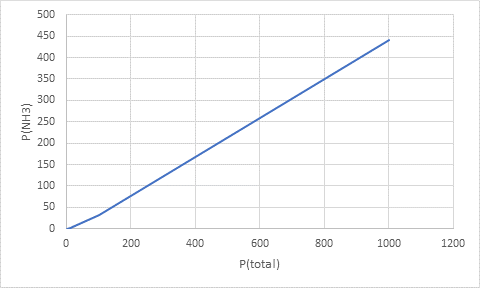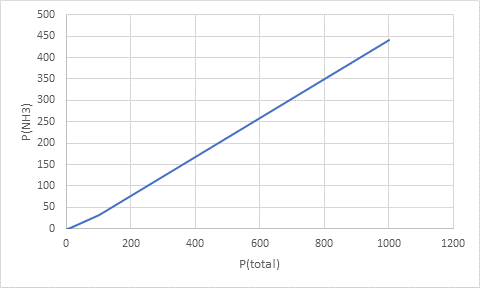
Interpretation: A plot for the variation of partial pressure of
Concept Introduction: The relationship between reactants and products of a reaction in equilibrium with respect to some unit is said to be equilibrium expression. It is the expression that gives ratio between products and reactants. The expression is:
Answer to Problem 111CP

Explanation of Solution
Given:
Initial moles for the ammonia synthesis reaction is:
At
The complete balanced reaction for the formation of ammonia is:
From the balanced reaction it is observed that 1 mole of nitrogen gas reacts with 3 moles of hydrogen gas to produce 2 moles of ammonia gas.
- For the total pressure of 1.0 atm:
Let the partial pressure of nitrogen gas be x atm so, the partial pressure of hydrogen gas will be 3x atm. Thus,
Solving for x:
So, the partial pressure of nitrogen gas is
The ICE table for the reaction will be set up as:
The expression for the equilibrium constant is:
Substituting the values:
Assuming the change be small so,
Solving for x:
The correct value of x is calculated by substituting the assumed x value as:
The value of x is used and this process is repeated until the value of x does not vary:
Since, the value x has not changed so, this value of x used. Thus, the partial pressure of ammonia is:
- For the total pressure of 10.0 atm:
The ICE table for the reaction will be set up as:
The expression for the equilibrium constant is:
Substituting the values:
Assuming the change be small so,
Solving for x:
The correct value of x is calculated by substituting the assumed x value as:
The value of x is used and this process is repeated until the value of x does not vary. So, the calculated values of x are:
Since, the value x has not changed so, this value of x used. Thus, the partial pressure of ammonia is:
- For the total pressure of 100.0 atm:
The ICE table for the reaction will be set up as:
The expression for the equilibrium constant is:
Substituting the values:
The value of x is calculated using successive approximations as:
Solving for x:
The correct value of x is calculated by substituting the assumed x value as:
The value of x is used and this process is repeated until the value of x does not vary. So, the calculated values of x are:
Since, the value x has 16 is repeated so, this value of x used. Thus, the partial pressure of ammonia is:
- For the total pressure of 1000.0 atm:
The ICE table for the reaction will be set up as:
The expression for the equilibrium constant is:
Substituting the values:
The value of x is calculated using successive approximations as:
Solving for x:
The correct value of x is calculated by substituting the assumed x value as:
The value of x is used and this process is repeated until the value of x does not vary. So, the calculated values of x are:
Since, according to significant digits, the value x has 220 is repeated so, this value of x used. Thus, the partial pressure of ammonia is:
Thus, the values of partial pressure of ammonia at total pressures are:
| total pressure (atm) | partial pressure of ammonia(atm) |
| 1.0 | 0.024 |
| 10.0 | 1.4 |
| 100.0 | 32 |
| 1000.0 | 440 |
Plotting the data as:

Want to see more full solutions like this?
Chapter 6 Solutions
Chemical Principles
- Can you explain how I get these here and show the steps plz?arrow_forwardGive the IUPAC name for this compound Hydrocarbon Condensed Formulas Hint C2H5 CH2CH3 expand that in all the formula Part A: (CH3)2CHCH(C2H5)CH2CH2CH3 Give the IUPAC name for this compound. Part B: CH2=C(C2H5)CH2CH2CH3 Give the IUPAC name for this compound. Part C: (CH3)2C=CHC(C2H5)=CH2 Give the IUPAC name for this compound. Part D: CH3C=CCH(C2H5)2 Give the IUPAC name for this compound. Part E: (CH3)3CC=CCH2CH=C(CH3)2arrow_forwardSelect/ Match the correct letter from the image below for the IUPAC names given below: A B C D 3 E F G H K L Part 1. 4-methylheptane For example.mmmm Answer Letter H _for part 1 Part 2. 2,4-dimethylhexane Part 3. 2,3-dimethylpentane Part 4. 2,2-dimethylhexane Part 5. 2-ethyl-1,1,3,3-tetramethylcyclopentane Part 6. 3-ethyl-2-methylpentanearrow_forward
- Can u show the process as to how to get these?arrow_forwardSketch the expected 'H NMR spectra for the following compound. Label all of the H's in the structure and the corresponding signal for the spectra you sketch. Make sure you include the integration value and the splitting pattern for each signal Indicate how many signals you would expect in the 13C NMRarrow_forwardUse IUPAC naming rules to name the following hydrocarbon compounds: CH2-CH3 | a) CH-CH-CH2-CH-CH-CH3 b) | CH2 CH3 | CH3 CH3 \ / C=C H 1 H CH2-CH3 c) d) CH=C-CH3 e) CH3-CH2-CH2-CH=CH-CH3 f) CH2=CH-CH2-CH=CH-CH3 g) CH3-CH2-C = C-CH2-CH3 h)arrow_forward
- Q5 Name the following : a. b. C. d. e.arrow_forward25. Predict the major product of the following reaction. 1 equivalent of each of the starting materials was used. H₂C CH3 CH3 H3C H3C H3C. CH2 + H3C. heat CH3 CH H.C. CH3 H.C H.C CH3 CH CH3 CH3 A B C Earrow_forwardFind chemical structures based on the below information. a) Chemical formula C6H8O Compound is aromatic plus has two 1H NMR peaks that integrated for 3 each that are singlets (it could have more peaks in the 1H NMR b) Chemical Formula: C6H100 Compounds is conjugated 'H NMR has a signal that integrates for 6 and is a doublet IR spectra has a signal at 1730 cm-1arrow_forward
- Jaslev Propose a synthesis of the following starting from benzene and any other reagents and chemicals. No mechanisms are required. Indicate the condition for each step plus the major product for each step. More than two steps are required. Step 1 Step 2 مہد Brarrow_forwardPart C: The line formula for another branched alkane is shown below. i. In the IUPAC system what is the root or base name of this compound? ii. How many alkyl substituents are attached to the longest chain? iii. Give the IUPAC name for this compound.arrow_forwardPart D: Draw the Structural Formula for 4-ethyl-2-methylhexane Part E. Draw the Structural Formula for 1-chloro-3,3-diethylpentane (Chloro = Cl)arrow_forward
 Chemistry: The Molecular ScienceChemistryISBN:9781285199047Author:John W. Moore, Conrad L. StanitskiPublisher:Cengage Learning
Chemistry: The Molecular ScienceChemistryISBN:9781285199047Author:John W. Moore, Conrad L. StanitskiPublisher:Cengage Learning Chemistry: Principles and PracticeChemistryISBN:9780534420123Author:Daniel L. Reger, Scott R. Goode, David W. Ball, Edward MercerPublisher:Cengage Learning
Chemistry: Principles and PracticeChemistryISBN:9780534420123Author:Daniel L. Reger, Scott R. Goode, David W. Ball, Edward MercerPublisher:Cengage Learning General Chemistry - Standalone book (MindTap Cour...ChemistryISBN:9781305580343Author:Steven D. Gammon, Ebbing, Darrell Ebbing, Steven D., Darrell; Gammon, Darrell Ebbing; Steven D. Gammon, Darrell D.; Gammon, Ebbing; Steven D. Gammon; DarrellPublisher:Cengage Learning
General Chemistry - Standalone book (MindTap Cour...ChemistryISBN:9781305580343Author:Steven D. Gammon, Ebbing, Darrell Ebbing, Steven D., Darrell; Gammon, Darrell Ebbing; Steven D. Gammon, Darrell D.; Gammon, Ebbing; Steven D. Gammon; DarrellPublisher:Cengage Learning Principles of Modern ChemistryChemistryISBN:9781305079113Author:David W. Oxtoby, H. Pat Gillis, Laurie J. ButlerPublisher:Cengage Learning
Principles of Modern ChemistryChemistryISBN:9781305079113Author:David W. Oxtoby, H. Pat Gillis, Laurie J. ButlerPublisher:Cengage Learning Chemistry: Principles and ReactionsChemistryISBN:9781305079373Author:William L. Masterton, Cecile N. HurleyPublisher:Cengage Learning
Chemistry: Principles and ReactionsChemistryISBN:9781305079373Author:William L. Masterton, Cecile N. HurleyPublisher:Cengage Learning Chemistry & Chemical ReactivityChemistryISBN:9781337399074Author:John C. Kotz, Paul M. Treichel, John Townsend, David TreichelPublisher:Cengage Learning
Chemistry & Chemical ReactivityChemistryISBN:9781337399074Author:John C. Kotz, Paul M. Treichel, John Townsend, David TreichelPublisher:Cengage Learning





